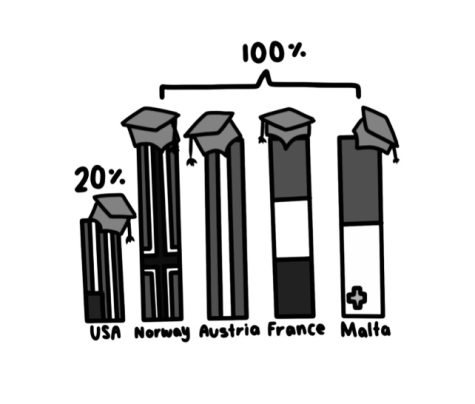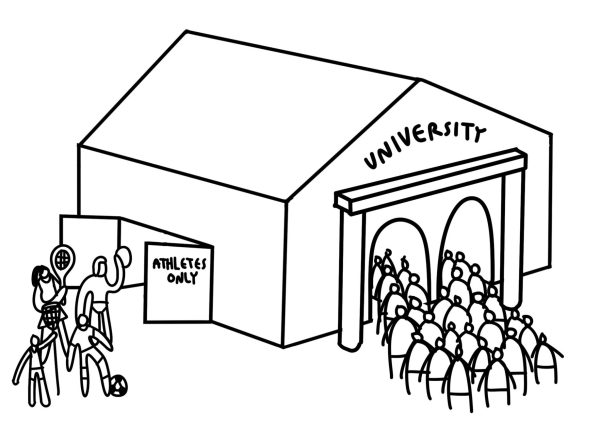Let’s talk foreign language
June 9, 2022
A median of 92 percent of kindergarten through 12th grade (K-12) students in Europe learn a second language in their schools, according to Pew Research. Yet, the American Councils for International Education found that across the U.S., only 20 percent of K-12 students are enrolled in foreign language classes. Countless studies have linked learning a second language to a higher degree of brain development and lower chances of advanced dementia, but American schools still do not prioritize foreign language classes. American K-12 schools must recognize the increased opportunities that second language classes can provide to their students both intellectually and academically. K-12 schools should require a foreign language class every year to further develop young minds, reduce the effects of aging on the brain, improve education in the U.S. and open up more jobs for students in the future.
Research demonstrates that learning a second language is linked to advanced brain development, which is especially applicable to children and teens whose brains are still growing. According to a Washington Post interview with psycholinguist – an expert in the relations between language and psychology – Mark Antoniou of Western Sydney University, bilingualism improves certain brain functions and assists in brain development. “The first main advantage [of bilingualism] involves what’s loosely referred to as executive function. This describes skills that allow you to control, direct and manage your attention, as well as your ability to plan,” Antoniou said.
In addition to enhancing one’s attentiveness, Antoniou mentions that learning a second language increases a student’s number of brain cells and dendrites, as well as makes gray matter denser, an indication of a healthier brain.
Similarly, learning a second language may reduce the effects of Alzheimer’s and brain decay. By actively engaging the human brain in new languages, being bilingual promotes longer and healthier lives. In fact, bilingual individuals with neurodegenerative diseases often function at a higher level than anticipated.
According to Antoniou, this is typically the case since “a bilingual brain can compensate for brain deterioration by using alternative brain networks and connections when original pathways have been destroyed.”

Comparable to how other countries are surpassing the U.S. in subjects such as math, international students are far more advanced than their American counterparts in both the number of languages they are taught and their fluency. Many argue that the U.S. lags behind other nations in bilingualism because the U.S. covers more land and has fewer bordering countries and language diversity compared to countries in Europe or Africa, so there is less exposure or a need to learn other languages. However, CNBC reports show there are still 350 other languages spoken in the U.S., and there is no official language in the United States, despite the cultural dominance of English. This proves that those who learn a second language in the U.S. will still be able to put their skills to use and become part of a community of multilingual Americans. Additionally, America’s large trend of immigration has generated a mix of cultures and languages, leading to a greater need for bilingual education.
At Redwood, only 28 percent of students are fluent in more than one language, according to a May 2022 Bark survey. In contrast, 60 to 75 percent of people internationally speak at least two languages, according to the British Broadcasting Corporation (BBC). As America falls behind other countries in foreign language education, it continues to hold back children from accessing opportunities beyond the classroom.
Outside of the classroom, multilingual workers are provided more opportunities in both the global and domestic economy. Moreover, learning a second language can significantly increase one’s salary. According to U.S. News, “ … those entering the workforce in 2014 with second language fluency can expect an additional 10 to 15 percent pay increase.” In addition, bilingual job applicants provide an advantage to their employers, making them more valuable. Forbes, an American business magazine, stated, “A multilingual employee isn’t simply a cost-saver when it comes to having an in-house translator for important business meetings or transactions. It also helps build better client relationships by demonstrating an interest in their culture and an investment in their language.” Learning a second language fulfills an essential skill in the workforce, the ability to foster connections and relationships with people, even across language barriers.
Naturally, a large setback to implementing widespread foreign language classes in K-12 schools is a lack of funding, especially in public schools. While this is a valid concern, language should be treated as a priority on par along with the four core classes, including math, science, English and social studies. Unfortunately for Redwood, French 7-8 may be cut starting next year due to decreased enrollment and budgeting. This will discourage students’ curiosity in learning other languages and put students at a disadvantage compared to others internationally. According to a recent Bark article, junior French student Stella Cico said, “Without French 7-8, you don’t know enough to hold meaningful conversations. … It is the first high-level French class where you begin to develop and dive into the language. If this class is not offered at Redwood, I will have to look at taking it at [College of Marin] or elsewhere.”
Due to its beneficial health impacts and proven usefulness in everyday and corporate life, foreign language classes should be an academic priority. Many prestigious universities already prioritize second language learning, such as Harvard, which considers competitive applicants as those who have taken four years of high school language along with four years of the other core classes.
It is necessary that the U.S. puts children’s health and education first and provide them with foreign language skills to open their minds, build multicultural connections and truly engage in the real world.






















